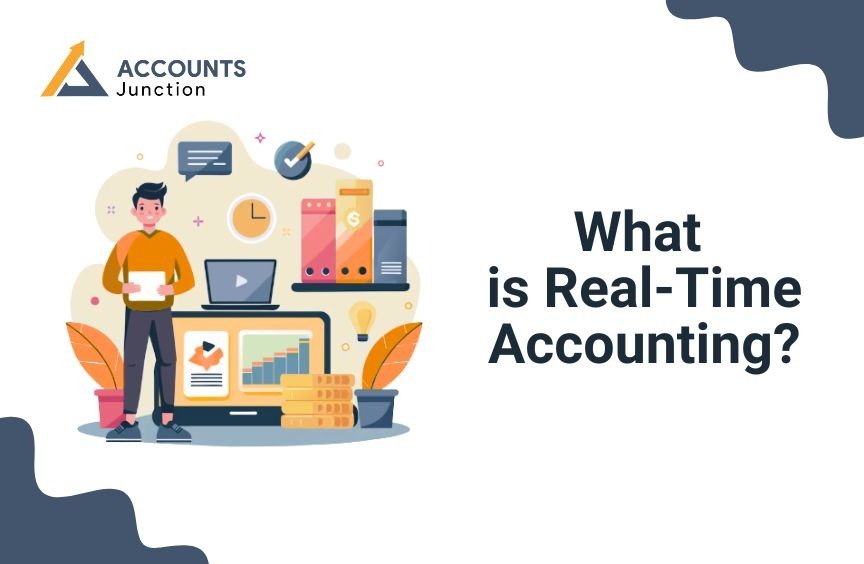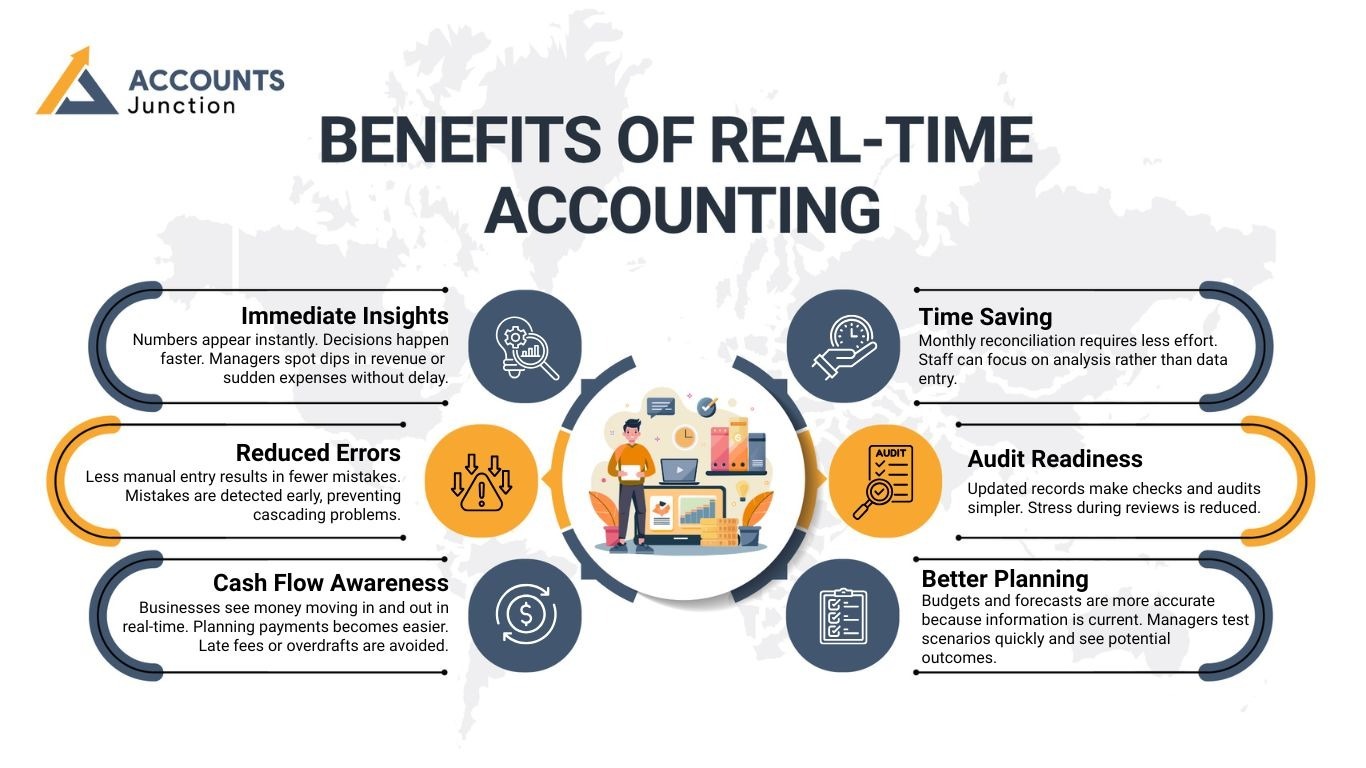
Real time accounting
In many businesses, money can feel like a moving target. Tracking every sale, payment, or cost is often exhausting. Some firms still rely on old methods of recording transactions. In those cases, data sits for days or weeks before anyone sees it. Real-time accounting changes that. It gives a live view of finances for faster decisions and error spotting. It is not magic, but it simplifies understanding. Planning, tools, and effort are needed for real-time accounting to work well.
Real-time accounting may sound complex, but it is not as hard as it seems. At its core, it records transactions as they happen. Businesses see what is happening with money at any moment. This helps owners plan, adjust, or prevent mistakes. Some trends remain hidden without it. Budgeting often becomes easier. The overall picture of finances feels clearer and more manageable.
Understanding Real-Time Accounting
Many wonder what makes it different from traditional methods. Traditional accounting updates accounts at the end of the week or month. Real-time accounting captures transactions instantly. Every payment, invoice, or expense appears in the system immediately.
This approach provides a clear, up-to-date picture. Managers can check cash flow without delay. They see sales trends as they unfold. Expenses are visible before they pile up. Some assume it is only useful for large firms, yet even small businesses benefit. With proper software, the advantages are substantial.
Real-time accounting reduces errors. Recording numbers instantly allows mistakes to be caught faster. Reconciliation becomes simpler. Delays that create confusion disappear. Managers gain confidence in decisions because they rely on current data. Stress reduces when waiting for monthly reports is no longer necessary.
How Real-Time Accounting Works
How does it operate exactly? While processes vary, some patterns are common in the working of real-time accounting:
1. Instant Data Capture
-
Transactions appear immediately in software. Sales, invoices, or bank entries flow directly into accounts. Manual entry is rarely needed. Some businesses use apps to log expenses on the go. Managers see costs before they accumulate, preventing surprises.
2. Automatic Updates
- Accounts adjust automatically. Reports reflect the latest numbers without waiting. Managers can view balances, profits, or losses instantly. Alerts may pop up when unusual activity occurs. Firms often set limits to be warned about overspending.
3. Continuous Monitoring
- Cash flow, payments, and income stay visible at all times. Decisions are faster because numbers are fresh. Patterns in spending or revenue become easier to detect. Strategies can be adjusted as trends appear.
4. Integration
- Systems link payroll, inventory, and customer tools automatically. This creates a complete financial picture. Teams communicate better because everyone sees the same data. Reports feel more reliable since they pull information from multiple sources at once.
Benefits of Real-Time Accounting
The benefits of real-time accounting are as follows:
- Immediate Insights
Numbers appear instantly. Decisions happen faster. Managers spot dips in revenue or sudden expenses without delay.
- Reduced Errors
Less manual entry results in fewer mistakes. Mistakes are detected early, preventing cascading problems.
- Cash Flow Awareness
Businesses see money moving in and out in real-time. Planning payments becomes easier. Late fees or overdrafts are avoided.
- Better Planning
Budgets and forecasts are more accurate because information is current. Managers test scenarios quickly and see potential outcomes.
- Audit Readiness
Updated records make checks and audits simpler. Stress during reviews is reduced.
- Time Saving
Monthly reconciliation requires less effort. Staff can focus on analysis rather than data entry.
Some people feel real-time accounting creates a live map of their finances. Transactions appear as if being watched constantly. Decision-making becomes informed and less like guesswork.
Challenges of Real-Time Accounting
While it sounds perfect, there are certain challenges in real-time accounting:
- Dependence on Technology
Systems fail occasionally. Updates may stop, requiring backup plans.
- Costs
High-quality software requires investment. Small firms sometimes start with basic tools and upgrade later.
- Learning Curve
Staff needs time to adapt to new tools. Training is essential. Patience is needed while employees adjust.
- Data Overload
Continuous updates can overwhelm without management. Focusing on key reports or setting alerts prevents distraction.
- Security Concerns
Online data is vulnerable without safeguards. Investing in security software and training staff is necessary.
Real-Time Accounting vs Traditional Accounting
Understanding the difference clarifies why real-time systems are useful. Here’s the complete difference:
|
Feature |
Traditional Accounting |
Real-Time Accounting |
|
Update Frequency |
Weekly or monthly |
Immediate |
|
Error Detection |
Slow |
Fast |
|
Decision Making |
Delayed |
Prompt |
|
Data Entry |
Manual |
Automated |
|
Integration |
Limited |
Extensive |
Real-time accounting delivers speed and clarity. It also demands more from technology and staff. Some feel overwhelmed at first. Others adjust quickly and notice clear benefits.
Tools That Help in Real-Time Accounting
Several tools simplify real-time accounting.
- Cloud Accounting Software
Programs sync bank, invoices, and sales instantly. Some generate reports automatically.
- Payment Systems
Incoming funds appear immediately. Refunds update without delay.
- Expense Apps
Staff log costs immediately. Receipts are scanned and uploaded fast.
- Inventory Software
Stock movements link to accounts automatically. Managers spot shortages before problems occur.
- Dashboard Reports
Charts show trends, alerts, and patterns live. Dashboards are often customizable to suit team needs.
Who Benefits Most from Real-time Accounting
Not every business requires real-time accounting. Yet some see major advantages. Here are they:
- Small Businesses
Cash flow is easier to track. Small problems are spotted early.
- E-Commerce Stores
Payments and refunds appear instantly. Promotions and stock are adjusted quickly.
- Large Companies
Departments coordinate faster. Multiple locations are monitored simultaneously.
- Startups
Quick decisions support growth. Strategies pivot swiftly based on current numbers.
- Freelancers
Invoices and expenses remain updated. Net income is always visible.
Common Misconceptions About Real-time Accounting
Some misunderstand real-time accounting. Here are some misconceptions regarding real-time accounting:
- Only for Big Companies
Small firms also use it effectively.
- Removes Accountants
Professionals continue analyzing and planning.
- Error-Free
Mistakes still occur, but detection is faster.
- Guarantees Profit
Numbers help decisions but do not guarantee outcomes.
Some assume it is complex. Others find it simple once software is set up. Investment is often balanced by efficiency gains.
How Real-Time Accounting Shapes the Future
The future favors speed and clarity. Businesses rely on live numbers for budgeting, planning, and audits. Artificial intelligence analyzes transactions quickly. The number of businesses using real-time accounting are slowly decreasing. Transparency has become standard for modern businesses.
Soon, many businesses will adopt cloud-based accounting. Quick decisions, less errors, and financial clarity has become possible with real-time accounting. Growth depends on timely insights, and live reports help in providing strategy and action.
Real-time accounting does not fit every business. Yet it delivers speed, clarity, and fewer errors. With proper tools and trained staff, the financial picture becomes clear. It does not guarantee success, but it empowers smarter, faster choices. Real-time accounting transforms how firms think about money. At Accounts Junction, we provide real-time accounting support for businesses of all types. Contact us now to make your growth more visible. Simplify financial planning and plan for the future ahead with more clarity.
FAQs
1. What is real-time accounting?
- It is a way that records transactions instantly as they happen. Businesses can watch numbers move and change almost like they are living.
2. How is it different from traditional accounting?
- Traditional methods wait for weeks to update records. Real-time accounting shows balances immediately and may reveal trends fast.
3. Can small businesses use it?
- Yes, even small firms can adopt it with the right software. They can track cash flow and expenses more clearly without waiting.
4. Does it reduce errors?
- It reduces mistakes by limiting manual entry. Errors can still appear, but they are usually caught faster.
5. Is software needed?
- Cloud tools often make it simpler. They may link banks, invoices, and payments so everything updates automatically.
6. Can it improve cash flow?
- Yes, seeing money coming in and going out helps plan spending. Late fees and overdrafts can be avoided when numbers are live.
7. Is it expensive?
- Some programs cost more than others, but choices exist for every budget. Businesses can start simple and upgrade later if needed.
8. Does it remove accountants?
- No, accountants continue analyzing, checking, and planning. Software supports their work, making decisions more informed.
9. Is storing data online safe?
- Mostly yes, when proper security is in place. Encryption and strong passwords usually keep records protected.
10. Can it help in audits?
- Yes, because records are always current. Auditors can check transactions easily without waiting for monthly statements.
11. Do staff need training?
- Yes, learning new tools takes time. Staff may need guidance to use the software efficiently without mistakes.
12. Can it track inventory?
- Yes, stock can link directly to accounting records. Managers can notice shortages or overspending before they become problems.
13. Is it good for freelancers?
- Yes, it keeps invoices, payments, and expenses up to date. Freelancers may know their net income at any moment.
14. Does it guarantee success?
- No, it offers insights but not profit. Businesses still need to act wisely on the data to achieve results.
15. How fast are updates?
- Transactions appear instantly or in minutes. This allows managers to react quickly and adjust plans if needed.
16. Can AI work with it?
- Yes, artificial intelligence can analyze transactions and suggest insights. Alerts or trends may appear automatically.
17. Are cloud tools required?
- Not strictly, but they simplify work. Real-time numbers are easier to access from anywhere with a cloud system.
18. Can e-commerce stores use it?
- Yes, payments, refunds, and orders update automatically. Stores can manage stock and finances without delay.
19. Does it need internet?
- Yes, most systems rely on connections. Offline use may limit real-time updates until the system reconnects.
20. Is it the future of accounting?
- It is growing as a standard because speed and clarity are valued. Firms that adopt it often see fewer surprises and better insights.

